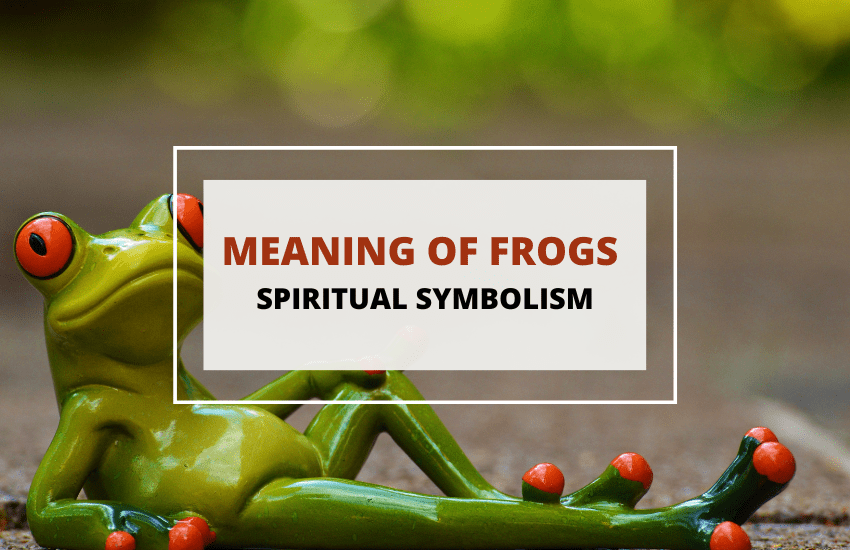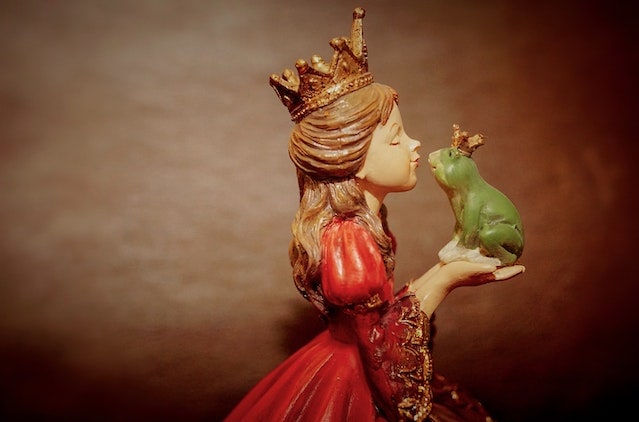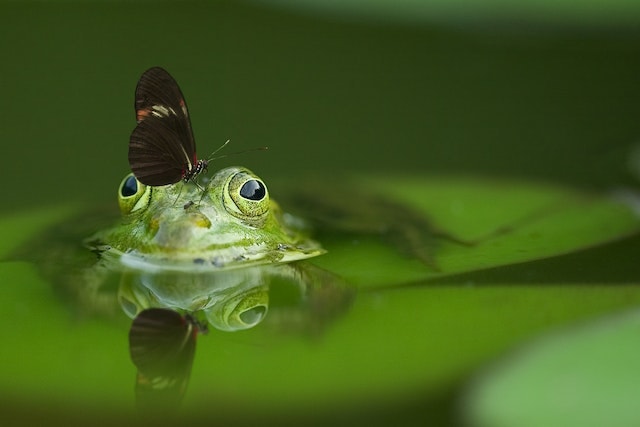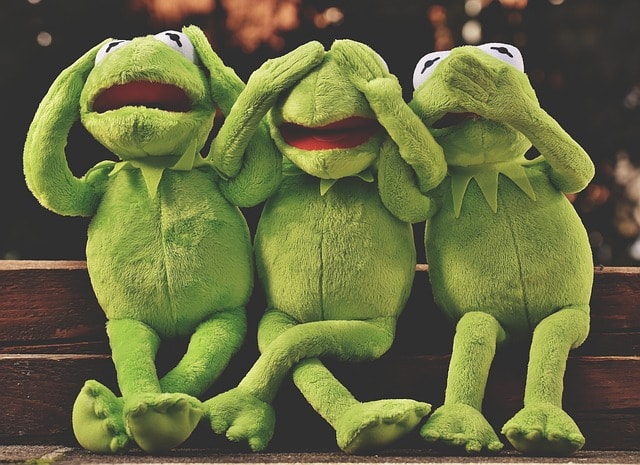
Table of Contents
Frogs have inhabited the planet alongside humans for thousands of years, and over this time, they have acquired various symbolic meanings.
Sometimes depicted as a curse on humanity, heralding pestilence and plague, and at other times as good luck omens, that bring fertility, abundance, and protection, the symbolism of frogs is complex and sometimes contradictory.
Let’s take a look at frogs, their spiritual meaning, and what they represent in different cultures.
Frogs – A Brief Overview
At first glance, frogs may look unappealing because of their appearance and the environment they usually live in, but they are actually crucial to the ecosystem. Their diet consists of insects, which helps reduce infestation in the environment. They also secrete substances from their skin that are used as key ingredients for antibiotics and painkillers.
Some frogs are poisonous and must be handled with care, but in general, frogs are quite sensitive and vulnerable creatures because of their body structure. They eat, drink, and sometimes even breathe through their skin, which means that they can easily absorb elements and foreign substances from their environment.
This is why many species of frogs are currently endangered. Natural and man-made threats like the destruction of the natural habitat due to chemicals and drug residue, water pollution, climate change, acid rain, and global warming have resulted in either death or severe birth deformities in frogs.
What Do Frogs Represent – General Symbolism
Researchers have found that frogs existed as early as 250 million years ago, much earlier than the era of dinosaurs. Since then, they have evolved many times, from what was initially a small amphibian, with a flat body, to the frogs that we know today.
With such a long history, seeing them deeply embedded in different cultures is not surprising. As a result, there’s a lot of symbolism, myth, and lore surrounding these amphibious creatures, passed down by spiritual beliefs and ancient traditions.
Here are some of the spiritual concepts associated with frogs.
Death, Rebirth, and Spiritual Transformation

Much like butterflies, certain aspects of a frog’s life relate to renewal, rebirth, and transformation.
During their life cycle, they start from being a simple egg, then they evolve into tadpoles, and finally, transform into fully formed adult frogs, capable of not just swimming in the water, but also moving through the land.
As a result of these significant physical changes that they go through in each of these stages, their lifecycle is often associated with transmutation and spiritual transformation.
So, as the frog goes through a complete metamorphosis, it can represent a person’s transformation once they let go of a dark past or regrets that may have been holding them back.
Frogs also shed off their skin like snakes, but they don’t just leave it behind. Instead, they push the shedding skin into their mouth and consume it in order to recycle their waste. This habit was considered to be a symbol of rebirth by some ancient cultures, such as the Olmec tribe, the earliest known major Mesoamerican civilization.
This is why their god of rebirth is a toad that is reborn by consuming itself, thus continuing the cycle of death and rebirth.
Adaptability, Renewal, and New Beginnings
Because of their amphibious nature (ability to live easily on land and water), frogs are seen to represent change and the ability to adapt to different circumstances.
Some people believe that when a frog frequently appears in front of you, it is a reminder to embrace change and not be afraid because it is an opportunity for growth and improvement.
Also, frogs tend to become more active in spring, when the weather starts getting warmer again. This is another metaphor for why they are associated with renewal and a fresh start.
Fertility, Childbirth, and Reproduction

Female frogs can lay as many as 30,000 eggs every year, depending on the species. This is one of the reasons why they have been associated with fertility in some cultures.
One example is the Ancient Egyptian culture that worshiped Heqet, the goddess of childbirth. According to Egyptian culture, Heqet is depicted as a frog or as a frog with a woman’s body.
She is believed to hold power over the baby’s body and life in the womb and the safety of both mother and child during labor and delivery. So, pregnant women would often carry frog-shaped amulets and pray for safe delivery.
Healing, Cleansing, and Protection

For some cultures, frogs symbolize healing and protection. The Celts referred to frogs as rulers of the Earth and associated the animals with healing and cleansing because they are often found near water sources like wells and rivers, which were sacred to the Celtic culture.
Native customs in North and South America and some parts of Europe also see frogs as healers and mention that their songs can contain divine powers to drive away evil spirits.
In medieval times, the British would use a “toad-stone”, believed to be taken from the head of a toad, as an antidote to poison. This stone was also believed to change color or warm up when detecting toxins, which enables the wearer to avoid getting poisoned.
Meanwhile, in Japan, frogs represent protection, especially when traveling. This is why many Japanese would often bring a frog amulet with them before heading out on a journey. The Japanese word for frog is “kaeru,” which also means “return.”
Several other cultures also believe that frogs are spirit messengers sent to cleanse people of negative thoughts and allow them to embrace their true selves.
Ignorance of One’s Limitations

In Eastern countries, there is a famous story about a frog that was trapped at the bottom of a well.
With his vision and life experiences limited within the confines of the walls surrounding the well, the frog was boastful of its beauty and knowledge, not knowing that a much wider world was waiting for him outside. This is where the origin of the most well-known phrase “Like a frog at the bottom of a well” comes from.
This is commonly used to describe a person who is ignorant and short-sighted or someone who has a narrow point of view due to his limited experiences and superficial understanding of the world.
Wealth, Good Luck, and Prosperity

Frogs are also believed to be harbingers of wealth, prosperity, and good fortune. In Chinese culture, for example, there is a frog spirit called Ch’ing-Wa Sheng who brings good luck, prosperity, and healing for business.
They also have a three-legged golden toad called Jin Chan, who is said to appear on a full moon near houses that are about to receive blessings. This is why the money frog is a popular feng shui charm commonly placed inside dwellings and businesses in China.
In Panama, you can see golden frogs practically everywhere. Aside from being the country’s national animal, locals also associate it with good fortune.
According to local legends, the golden frog turns into real gold after its death, and anyone who encounters it while it’s alive will receive wealth and abundance. As such, images of the animal would be printed on shirts, lottery tickets, magazines, and souvenirs for good fortune.
Wrapping Up
Frogs have been around for more than 200 million years and are an essential part of the ecosystem. Through these years, they have gone through so many changes, and this process of evolution, along with their natural life cycle, has made them a symbol of rebirth and transformation.
Observing this resilient nature of the frogs, people throughout different cultures have associated them with fertility, abundance, rebirth, healing, protection, and new beginnings.








